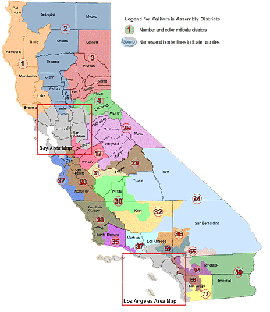
California map of Counties. (Photo: Pinterest)
The Citizens Redistricting Commission
The CRC consists of 14 members with specified political party registration
By Chris Micheli, August 5, 2020 6:21 am
The California Citizens Redistricting Commission (CRC) is charged with completing the decennial job of drawing district lines for State Senators, State Assembly Members, U.S. Representatives, and State Board of Equalization Members. The CRC is established in Article 21 of the California Constitution, which deals with the redistricting of the senate, assembly, congressional, and board of equalization districts every ten years. This article of the state constitution was most recently amended by Proposition 11 on the November 4, 2008 ballot.
Article XXI contains the following three sections:
Section 1 states that, in the year following the year in which the national census is taken under the direction of Congress at the beginning of each decade, the Citizens Redistricting Commission must adjust the boundary lines of the Congressional, State Senatorial, Assembly, and Board of Equalization districts (also known as “redistricting”) in conformance with the standards and process set forth in this article of the state constitution.
Section 2 specifies that the CRC was created no later than December 31 in 2010, and in each year ending in the number zero thereafter. The section provides that the CRC must (1) conduct an open and transparent process enabling full public consideration of and comment on the drawing of district lines; (2) draw district lines according to the redistricting criteria specified in this article; and (3) conduct themselves with integrity and fairness.
The CRC consists of 14 members with specified political party registration and requires each commission member to be a voter who has been continuously registered in California with the same political party or unaffiliated with a political party and who has not changed political party affiliation for five or more years immediately preceding the date of his or her appointment. The commission must establish single-member districts for the Senate, Assembly, Congress, and State Board of Equalization pursuant to a mapping process using specified criteria.
Section 3 provides that the CRC has the sole legal standing to defend any action regarding a certified final map and that it must inform the Legislature if it determines that funds or other resources provided for the operation of the CRC are not adequate, in which case the Legislature must provide adequate funding to defend any action regarding a certified map.
In addition to these constitutional provisions, California Government Code Title 2, Division 1, Chapter 3.2 deals with the Citizens Redistricting Commission in Sections 8251 to 8253.6. Section 8251 deals with general provisions and Chapter 3.2 is intended to implement Article 21 of the state constitution by establishing the process for the selection and governance of the CRC.
The State Auditor randomly selects the first eight members, three who are Democrats, three who are Republicans, and two who are either decline-to-state or are registered with a third party. This occurs after the four legislative leaders exercise their authority to eliminate the names of 24 applicants from the pool of 60 of the most qualified applicants identified by the Auditor. Those either persons then choose the remaining six members. Together, they are responsible for drawing the new district lines.
- What Information Has to Be on the LegInfo Website? - April 19, 2024
- New Assembly Bill Would Ban NDAs in Legislative Negotiations - April 19, 2024
- Frequently Asked Questions about California Bills Having Certain Provisions - April 19, 2024





Get ready for more DEMOCRAT Gerrymandering (a word they push as if its only for describing republicans)